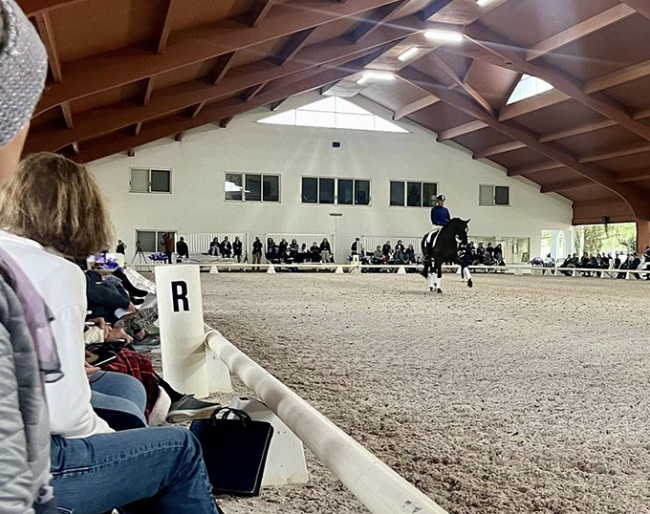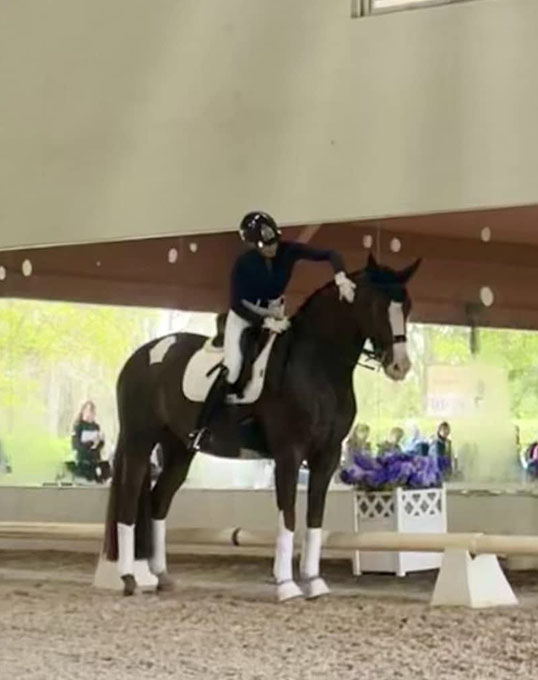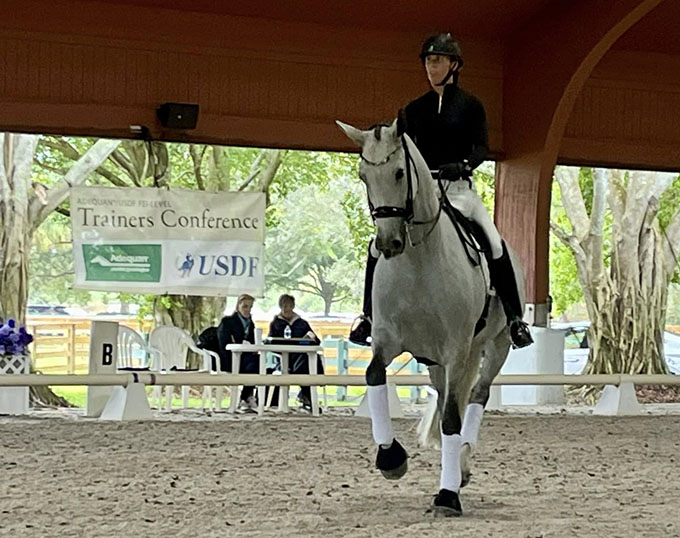
American professional dressage rider Eliza Sydnor Romm from Chapel Hill, NC, attended the 2025 USDF Trainers Conference at Mary Anne McPhail's High Meadows Farm, in Loxahatchee, FL, on 19 - 20 January 2025.
US team trainer Christina Traurig and German team trainer Monica Theodorescu paired up to provide two days of invaluable instruction.
Sydnor took quick notes with her take aways from the seminar. Here are her notes from day 1.
Hannah Irons - E.T.
Coming 5-year old Westphalian gelding by Escamilo. Taught by Christine.
Feel that you can neutralize your hand a little, so you tell your horse you are not going to hold him and help him all the time.
With a young horse who is still a little bit leaning, make sure you keep your shoulders open, so his contact doesn’t encourage you to round your shoulders.
Flexion before working on real bending and suppleness. He should stay flexed to the R on the circle, and your R hand should stay slightly away from the withers, not against the withers.
Beautiful type with such a steady tempo and contact. Absolute metronome in the trot and a super character dealing with all this atmosphere.
When leg yielding, you must feel if your leg aid immediately creates more stiffness or more running into the hand, then you are missing suppleness.
We must never underestimate the value of riding bent lines and transitions on bent lines.
Mistakes are never a bad thing. Mistakes are always a training opportunity.
When a horse is stiff, it’s always hard to go forward. You can just run faster, but you will need to aid and aid and aid. We must make him more supple.
Trot canter trot transitions for more suppleness. The transitions must be fluent and tension free. Meaning your aid for the transition must not create tension. It must not disrupt the flow through the body to go from one gait to another.
Not too deep in the corners for a young horse.
No leaning back. If he is pulling down on you and you need to lean back, you must ride a transition.
If your heel comes up, your knee comes up and open, and then you will feel like you need to start grinding from your seat.
Today we work on alignment and suppleness so your horse gets more supple on the stiffer side and more aligned on the hollow side. The inside hind leg will come more under the body as he gets more supple.
Inside rein is flexion and direction. Outside rein indicates direction of the shoulders.
Stay disciplined about your equitation.
In stretchy trot - the horse stretches in front of you, not behind you (not stretching out with the hind legs). Tempo maintains - not faster. The horse must make a polite stretch, not pulling down. There must still be an element of self carriage.
When the horse is stiff, the body is blocked. There is no sense sitting the trot when you feel your horse is stiff and tight.
Exercise - 4 loop serpentine with transitions to walk over each c line. Questions of suppleness, balance, reactions to the aids.
Exercise - Quarter line, leg yield out, 10 m circle and then a little shoulder in for the rest of the long side. You only have a few strides to do shoulder in, but that’s fine for a young horse.
Neve Myburgh - Firiet
7 year old DSP mare by Franklin. Taught by Monica.
Lets her warm up in a longer looser frame. Every horse is different and needs a different frame for warming up. Trot canter trot transitions to get the back swinging. L canter is a bit bigger, R canter is a little shorter/tighter.
Using counter canter to bring the frame up and out by making the horse sit in a better balance.
Counter canter sitting more on the short side, medium canter on the diagonal. So she sits and then has to push and open her stride. The canter improves and gets less tight and more ground covering.
The horse always wants to stay in the middle under the rider. The weight aid is the principle aid. When the rider sits correctly, it is all easier for the horse.
Exercise - 3 loop serpentine with a flying change over the c line. It’s quite hard to do well but makes the changes more even and tests many things.
We have lost many exercises in the tests that are very useful. These exercises take too long and are “boring” to watch. But since we have lost them in the tests, we are losing them in the training.
The top riders - we do counter canter every day to fix the balance, improve the collection, fix our own positions.
Trot work - shoulder in, half circle half circle, shoulder in the other way. Make sure the hindquarters don’t swing out on the circles.
In the half passes, keep the inside ear up a little. The rider must bring the inside shoulder back and keep the inside leg on.
Exercise - centerline, half pass left, shoulder in R on the track, repeat. She must go into shoulder in from a change in your body position.
Exercise - Short diagonal - medium trot, at the track, circle 10 m at B, then immediately short diagonal again medium trot. Then long diagonal sitting trot medium till X, then rising and ask her to keep pushing.
Chris Hickey and Saskatoon OMF
7 year old gelding by San Amour x Don Frederico, owned by Cecelia Stewart. Taught by Christine.

In the beginning this horse was quite stiff in the poll and strong in the contact. So he really had to learn to supple the poll, relax the jaw and let go.
Don’t force the horse to go towards what they are afraid of, ride an exercise that moves their body and supples them toward the scary thing.
It’s normal that the horse misunderstands the inside leg and thinks it means go more forward, but they gradually must learn that there is a bending leg, and the pressure from a bending leg must not increase the tempo. The outside leg has an important job of the guarding leg, so the horse doesn’t swing out, because then they do not really bend.
Exercise in warm up - canter down quarter line, and stride by stride move the horse back to the long side. Think that you leg yield up to the attic, not down to the basement.
As you collect, there is no backward riding, you are gathering the energy, gathering the hind legs up under you.
Chris has done a good job getting the transitions really committed - the departs are really clear and committed.
Counter canter right lead and be clear the shoulder fore R does NOT mean haunches L. Shoulder fore should only be 2.5 tracks, not 3. Influence the placement of the RH, control the LH.
Renvers to really test if the horse understands bending around the leg, through the whole body and connected to the outside rein. They can’t cheat as well in renvers.
The corners should be a set up for the next thing. The corner must really become a way you can supple them, improve the balance and prepare - every time!
Canter pirouettes - Christine doesn’t like starting with haunches in. The guidelines say turn of the shoulders in and around the horse’s inside hind. So that means you start with the shoulders.
On the 20 m circle in canter, once the canter and balance and alignment is good, then can you ride a correct travers. The browband of the horse must stay perpendicular to the circle line.
Amy Bradley on I Spy

3 loop serpentine in trot with walk transitions over each centerline. Being picky about immediately a clear rhythm into and out of the walk, and an easy change of flexion each direction.
In shoulder in L, both hands slightly to the L.
Exercise - halt - one step forward then turn on haunches, then halt again. You must start with the shoulders. The rider must sit into the direction of the movement. It’s important to halt him so that he really stands over all four feet.
In counter canter, think of riding in the direction of the inside rein. Three loop serpentine starting and ending in counter canter. Clear turning from the inside rein, that directs him into the new direction.
Heather Bender on Keisha B
9 year old KWPN mare by Genial. Taught by Christine.
Every transition from walk to canter and canter to walk should be done in shoulder fore forever more.
Centerline half pass in canter. Make sure you start in shoulder in and take time to begin, because when she hurried into it, the first stride went downhill instead of uphill.
Kate Shoemaker on Vianne
8 year old Hanoverian mare by Vitalis. Taught by Monica
So much correct, there is not much for Monica to improve!
Centerline and half pass in canter, you want to start with shoulder fore but not too much or a full on shoulder in, because then the quality of the canter deteriorates.
Walk to canter and canter to walk. Take your time. You are never in a hurry. The transition must happen on the hind leg.
The changes are so correct. She can ride them with a little more risk, a bit more energy and expression. Because the twos are more correct, just try quarter line and try a couple ones. So easy with such a mare who is so correct.

Some horses really do make it easy for us. She is so talented and so willing and so well trained, that you can just think of these concepts - these movements - and there is no struggle.
JJ Tate on Denali
10 year old Hanoverian gelding by Harmony’s Don Noblesse, owned by Cackie Vroom and Dean Wright. Taught by Christine.
Because he struggles with true bending, especially to the right, circle and give him flexion and then with feel, we wait for him to really let go into the flexion. Don’t flex and drop and flex and drop.
Quarterline leg yield out in canter. As soon as he tilts, you circle and you get more of a feel that he starts chewing on the bit, and relaxes in the TMJ.
Left canter is better than right. Forward and back in the canter, I want to see the the half halt is a little more repetitive and doesn’t just hold.
We don’t want to have compressed tension. The elasticity and adjustability needs to stay in the horse in collection.
Really think BENT around your inner leg before half pass. TAKE that bend into the half pass, because he’s stiffer.
After a lateral exercise that promotes collection, see if you can refresh the gaits with medium or extension.
For this horse, it’s ok to ride the walk to canter a little more “through to the flexion R” as he departs because he’s stiff there. Better to keep it good as he lifts into canter than to have him land stiff on the first stride.
The outside rein HAS to accommodate the degree of flexion the inside rein indicates.
Whenever you have a horse who is really compact (short coupled) they always look put together, but then it is really challenging to get a swinging, elastic back.
Exercise - 4 strides forwards 4 strides back in canter to encourage constant longitudinal elasticity.
In half pass, you as the rider have to assess - do I have a shoulder fore available? Or is he holding tension in the abdomen against my inner leg? If so, the half pass will not get better. You might have to pause it and use shoulder in.
Olivia LaGoy-Weltz on Fade to Black
10 year old Hanoverian mare, by Fantastic, owned by Mary Anne McPhail. Taught by Monica.
Mare was very concerned with the surroundings, so they took time to get her to relax and focus through walk work - lateral work, pirouettes, halts, rein back, etc.
When your horse is not patient, you have to be double patient. Although we have the same principles for all of them, every horse needs to be treated in a special way. There are many roads to Rome, but the foundation of the roads is the same.
In the tempis, because she wants to fall on the L shoulder, keep riding the shoulders to the R. Imagine your line turning very slightly to the R.
In trot work, she is pushing too much and running past her balance point. She has so much energy, but she must let you direct it. She has a lot of pushing power but she needs to get stronger in order to hold it, to carry.
Christine - Half Halt - the pre existing condition is that the horse must always be in front of the leg. Then the hand closes, the horse shifts weight back toward the hind legs and pushes away from the bit (abstossen) and then the contact can be “neutralized”. The components of the half halt can be neutralized when the half halt has been successful.
The outside aids are the edge of the dinner plate. The outside rein is the edge of the dinner plate for the shoulders of the horse. The outside leg of the rider is the edge of the dinner plate for the hind legs of the horse.
Read Sydnor's quick notes from day 2 on her Facebook Page.
Related Links
2024 USDF Trainers Conference: "Forward is a Lifestyle"
2024 USDF Trainers Conference - Part 2: "Systematic Work, Relying on the Basics"
Nuggets of Wisdom from the 2023 USDF FEI Level Trainers' Conference
Carl Hester's Wisdom: "Dedicate Yourself to Get Better, Nobody is Perfect"
McDonald, Traurig, Williams, Bredahl to Speak at 2019 USDF FEI-Level Trainers Conference
2018 USDF FEI-Level Trainers Conference with Johann Hinnemann in Del Mar, California
Demo Riders for 2018 USDF FEI-Level Trainers Conference
Hinnemann and Clarke to Head 2016 USDF Trainers Conference
Stephen Clarke to lead 2015 USDF FEI-Level Trainers Conference
Steffen Peters and Scott Hassler Headlining USDF FEI-Level Trainers' Conference